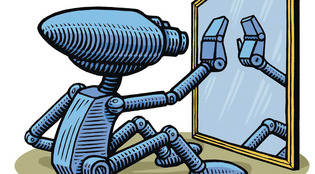 loading
loading
FindingsI, robot Gregory NemecView full image
Nico, a humanoid robot with cameras for eyes, is posing in front of a mirror, moving its jointed metal arm back and forth. Designed by Brian Scassellati, an associate professor in computer science, Nico is the first machine capable of identifying its own reflection. To do so, says Scassellati, it uses “this dumb simple algorithm.” The robot is programmed to compare what it sees in the mirror with its own movements. If the mirror shows an arm moving and Nico’s own arm is moving at the same time, Nico can conclude that it is looking at itself.
Traditionally, psychologists have considered the ability to recognize oneself in a mirror to be a high-level cognitive function—potentially a sign of self-awareness—restricted to intelligent species such as chimpanzees, elephants, and dolphins. But self-awareness, Scassellati says, generally implies an ability to think and reflect about oneself. These are traits Nico does not possess. What does Nico’s skill with mirrors tell us? That “maybe we shouldn’t be thinking of this as a high-level, complex thing,” Scassellati says. The experiment is typical of Scassellati’s work, which seeks to use robots not to perform tasks for humans but as a means of investigating the inner workings of human behavior and psychology. Instead of probing the minds of living creatures, Scassellati builds robotic approximations of them, seeking clues to how the brain functions. He is particularly interested in developmental psychology. By teaching robots basic social and cognitive skills, he hopes to find out how children learn. Not that Scassellati pretends there’s a perfect analogy between his programming and the circuitry of a living brain: “Just because we build something and it works on the robot, it never means that it works the same way on children.” He compares himself to an ornithologist building an airplane; learning what’s required to make an airplane fly won’t lead to a complete understanding of birds, but it can reveal forces and phenomena that birds must contend with. In the same way, robots can prompt provocative new ideas—perhaps uncovering research areas where “maybe we’ve been solving the wrong problem or looking at things the wrong way.” In designing a robot able to sort out sensory stimuli, a task essential to infant learning, Scassellati learned just how complex such a basic cognitive task can be. He had to program the robot to identify parts of its own body, to distinguish between animate and inanimate objects, to track others’ gazes, to recognize postural shifts and read body language, and more. “There’s some real complexity to social behavior in ways that are difficult for us to see on the surface because they’re so natural to us,” Scassellati says. But nothing is natural to a robot. Everything it does has to be programmed from scratch. Scassellati is now building on his earlier work, seeking to create a robot capable of learning about its own body and its capabilities, something most children pick up naturally. He hopes to use these robots to help identify and explain what might be going wrong in the brains of children with certain developmental disorders. To that end, much of his recent work has been in partnership with the Yale Child Study Center, where his models are being used to study autism. His lab may be filled with robots, but, Scassellati says, “my real core interest is in human social development.”
The comment period has expired.
|
|